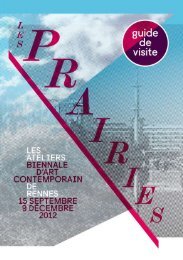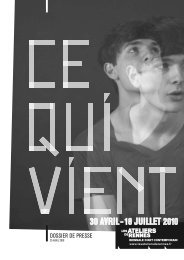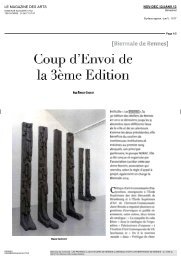Download here the Visitor's guide. - Les Ateliers de Rennes
Download here the Visitor's guide. - Les Ateliers de Rennes
Download here the Visitor's guide. - Les Ateliers de Rennes
You also want an ePaper? Increase the reach of your titles
YUMPU automatically turns print PDFs into web optimized ePapers that Google loves.
IAN KIAER<br />
Melnikov project, black faca<strong>de</strong>, 2011. Vue <strong>de</strong> l'installation.<br />
Courtesy of <strong>the</strong> artist and galery Alison Jacques, London, and Kunstverein of Francfort.<br />
<strong>Les</strong> Prairies's artists<br />
Ian Kiaer's art is <strong>de</strong>veloping around <strong>the</strong> concept of projects, using utopian architecture<br />
and its creators as a starting point. In keeping with <strong>the</strong> architectural mo<strong>de</strong>l, his<br />
installations are placed at floor level and on <strong>the</strong> walls. Their scale as mo<strong>de</strong>ls is also that<br />
of <strong>the</strong> project. The fragile materials, in spite of <strong>the</strong>ir ordinariness (packaging, plastic,<br />
cardboard, etc.) and <strong>the</strong>ir fa<strong>de</strong>d colours, situate his artworks at that intermediary stage<br />
between i<strong>de</strong>a, i<strong>de</strong>al and execution. His is a plastic art of composition and <strong>de</strong>tail and<br />
of <strong>the</strong> sublime colour of everyday objects in an imaginative vision, summoning up <strong>the</strong><br />
painting of an age that <strong>de</strong>picted reality as a dream. Ian Kiaer's pictorial and sculptural<br />
art occupies <strong>the</strong> same dimension as Utopia: <strong>the</strong> introspective and imaginary time<br />
dimension of potentialities in which reality is prepared. For <strong>Les</strong> Prairies Kiaer looked at<br />
<strong>the</strong> former telecommunications centre that Louis Arretche completed in 1972, an imposing<br />
building that exu<strong>de</strong>s utter confi<strong>de</strong>nce in Mo<strong>de</strong>rnist architectural style – a style, it has to<br />
be said, that already appeared somewhat dated in <strong>the</strong> seventies, as <strong>the</strong> Retro-futuristic<br />
aes<strong>the</strong>tic of <strong>the</strong> building indicates. The scale of <strong>the</strong> building, unlike <strong>the</strong> potential and<br />
introspective nature of "paper architecture", provoked <strong>the</strong> artist into a power struggle<br />
leading him to reflect on o<strong>the</strong>r mo<strong>de</strong>s of production. By acquiring and using some of <strong>the</strong><br />
original windows, Kiaer was able to rethink <strong>the</strong> architectural project as a proposition and<br />
a ruin, which he interpreted, using <strong>the</strong> architect's archives, in his own language through<br />
paintings, mo<strong>de</strong>ls and projections.<br />
A. B. tr. J.H.<br />
Born in 1971 in London (Great-Britain), w<strong>here</strong> he lives and works.<br />
Production<br />
<strong>Les</strong> <strong>Ateliers</strong> <strong>de</strong> <strong>Rennes</strong> 2012.<br />
53






